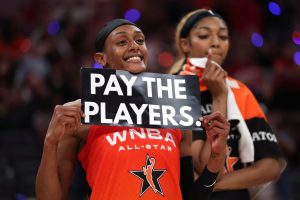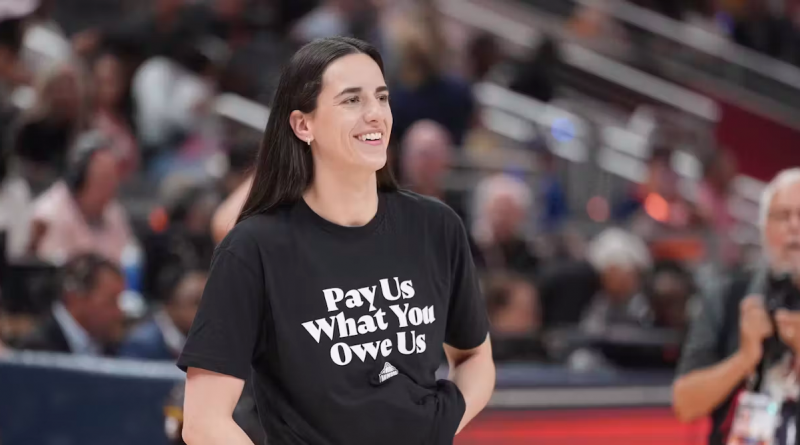The Leaguewide Message from WNBA Players: “Pay Us What You Owe Us”
Justin Loretz
Sports Editor & Staff Writer
There is no doubt that the Women’s National Basketball Association (WNBA) has experienced a dramatic increase in popularity over the past two seasons. Consequently, debates surrounding the wages that WNBA players currently receive have intensified tremendously. Just two months ago, during the All-Star break, players participating in the events throughout the league united to send a message that was impossible to miss, all wearing shirts that read “Pay us what you owe us.”

Today, people tend to cling to whatever suits their desired narrative, without taking the time to truly inform themselves, despite having all the information they need at their fingertips. As a result, a misconception has formed that what WNBA players are seeking is to be paid the same dollar amount as NBA players. But because this is the assumption by most, many arguments rest on a falsehood, particularly among critics, who argue such a demand is “delusional” pointing to the massive gap in revenue generated. They are “right” about this, but it is irrelevant—this level of pay is simply not what the athletes are looking to get. Instead, what they are asking for is a more favorable revenue sharing model. This number currently sits at about nine percent, which is about two times less than the players in the NBA receive (approximately 50%) (Mises Wire). However, this number does jump to 25% if the league surpasses its revenue target (KOAT).
There is one glaring issue that stands in the way: the WNBA operates at a net loss. Last season, the loss was estimated to be around $40 million (SportsPro). On the other hand, last season, the NBA brought in over $11 billion of revenue, a number that has been steadily increasing over the years (sportsvalue). The NBA owns forty-two percent of the WNBA (The Athletic), meaning their loss totaled $16.8 million. In other words, keeping the WNBA afloat costs the NBA roughly 0.15% of their revenue.
The WNBA is an asset and the NBA knows this, otherwise it would not exist. However, since its inception in 1996, the WNBA has not had a single profitable season (The Athletic). Truthfully, nothing can change if nothing changes, and that rings especially true here. The irony is that the NBA initially followed a nearly identical trajectory when it was introduced: in the first few decades of its existence, the league hemorrhaged money as teams folded left and right, and attendance was poor. For years, the NBA operated at a loss. It was only after the modern salary cap and revenue-sharing system was adopted in the 1980s that popularity surged and with it, profitability. The NBA can either choose to remain complacent and content, reaping the intangible, indirect benefits that the WNBA undeniably has on the NBA itself, or it can recognize the opportunity to shell out what is merely a fraction more as an active investment in the league’s future success.
If the salaries were raised by a relatively small amount, the incentive to play in the WNBA would drastically increase, competitiveness and the talent pool. Furthermore, another common pattern in society is that people perceive value based upon what is presented as valuable. There is no need to make it overly complicated, the WNBA would be taken more seriously and attract a larger audience if the players were simply paid more. Augmenting the price tags would make for a more accurate and respectable representation of the desirability many of these players possess. In turn, the public’s desire for involvement and consumption would rise. This is in large part due to the fundamental aspect of human nature known as mimetic desire, which, in short, suggests that people have an inherent tendency to imitate and adopt the desires of others, consciously or not.

If there were ever a time to invest in the growth of the WNBA, it is now. In just six years, league revenue has nearly doubled from $102 million to $200 million (MarketWatch). Additionally, from 2023 to 2024, the average WNBA viewership jumped an unprecedented 170 percent. (ESPN Press Room). Companies are following this trend—Nike, Google, and Gatorade, among them—capitalizing on the WNBA’s increased attention, which has only served to attract an even broader fanbase, while further proving that value begets value. Fortunately, the league plans on expanding from 13 teams to 18 by 2030, which will draw more attention and develop new and tighter fanbases, but the season also needs to be lengthened, as there are only 204 regular season matchups across the WNBA currently, as opposed to 1,230 in the NBA. Having a longer season would mean more TV inventory, more local sponsorships, and more opportunities for fan engagement—three proven drivers of league growth.

It is also true that many WNBA athletes actually play or have played overseas during the offseason as a means to supplement their income (e.g., Breanna Stewart, Kelsey Mitchell, etc.) (Sportico). This increases the risk of injury severely, while also deterring and dissuading international players from playing in the WNBA. Brittney Griner’s decision to play in Russia highlighted this issue on a global stage, only cementing the unfortunate reality of the risks and dangers that arise overseas.
The NBA’s own history proves that leagues can evolve from financial struggle into global dominance when fairer systems are in place. Why, then, cling to outdated disparities in revenue sharing when the WNBA’s growth curve mirrors the NBA’s early years? The WNBPA opted out of the current collective bargaining agreement (originally set to expire in 2027) and will instead meet at the end of this October. There is a good chance of a lockout or strike happening in the WNBA next season, so be prepared for a potential basketball drought in Summer 2026.
Contact Justin at justin.loretz@student.shu.edu

